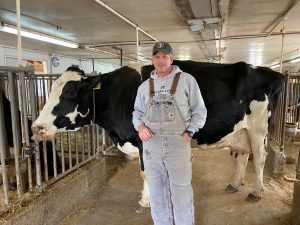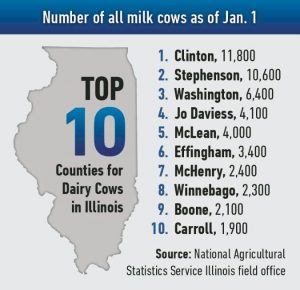Dairy Month spotlights a resilient industry in Illinois
By Daniel Grant FarmWeek — June 18, 2022
Michael Turley, a fourth-generation dairy farmer in Bond County, says high-quality care keeps cows like “Lovely” happy at Rolling Lawns Farm in Greenville. (Photo by Katie Zelechowski of Illinois Farm Bureau)
Things are generally looking up for milk producers this year after a long stretch of economic challenges.
USDA recently forecast average milk prices for 2022 at $25.75 per hundredweight for all milk, $22.75 for Class III and $23.80 for Class IV. If realized, the prices would be up from $5 to $7 per hundredweight compared to last year.
Tasha Bunting, Illinois Farm Bureau associate director of commodities and livestock programs who manages the Illinois Milk Producers Association (IMPA), discussed the state of the industry and promotional work taking place as part of June Dairy Month.
“Stronger prices are starting to come back. So, that’s certainly helpful to our dairy farmers in Illinois,” Bunting said. “We have definitely seen a shrinkage of the number of dairy farms the last several years.”
The number of licensed dairy farms in the U.S. contracted from 70,375 in 2003 to 31,657 in 2020, the American Farm Bureau Federation reported. Illinois has about 450 Grade A dairy farms with a total herd around 81,000 milk cows following a multi-year stretch of consolidation.
“Fortunately, our cow numbers aren’t shrinking quite as drastically,” Bunting said. “What that tells us is our farms are getting a little larger. And with that comes different efficiencies and ways to utilize those scales of economies to maybe get a better price for feed or inputs they need.”
June Dairy Month officially began in 1939 as an effort to promote sales during the annual spring flush of milk production and celebrate an industry that was facing economic struggles, which many farmers can relate to today.
“June Dairy Month is really a time dairy associations and dairy men and women throughout the U.S. promote and highlight the different products available and the headway all our farmers made on improving the industry,” Bunting said.

(National Agricultural Statistics Service Illinois field office)
IMPA will promote information about the dairy industry and provide dairy-related recipes at its website, www.illinoismilk.org, and Facebook page throughout the month.
IMPA to host Dairy Tech Tour
The association will also host its annual Dairy Tech Tour July 14 to highlight the latest advancements in the industry and give dairy farmers a chance to network.
The Dairy Tech Tour will be held at Beer’s Robo Holsteins Dairy Farm near Mascoutah.
“That farm uses robotic milkers and, from what I understand, it’s one of the first in the state to put robotic milkers in place,” Bunting said. “We’re going to talk to them about what they’ve learned the last 11 years and how that experience has gone.
“It (the dairy tour) is always a great time for our dairy farmers and those in the industry to connect.”
Dairy output, export opportunities grow
While the number of U.S. dairy farms decreased the past 20 years, the amount of milk produced by the industry actually increased 37 percent since 2001 due in part to improved efficiencies and genetics.
That not only reduced the industry’s footprint, but also positions it to meet growing demand around the world. Long-term global dairy consumption is projected to rise while the two largest suppliers, the European Union and New Zealand, face structural constraints that could limit the ability to significantly increase milk output in those places.
The U.S. is better positioned than any other country to grow milk and dairy production in a sustainable manner that meets rising global demand, if the industry continues to invest in exports, noted Krysta Harden, president and CEO of the U.S. Dairy Export Council.
The U.S. is the third-largest dairy exporter in the world with about 17% of its production shipped to other countries. USDA projects the industry could produce 226.7 billion pounds of milk this year, up from 226.3 billion last year.
The U.S. dairy industry also managed to reduce greenhouse gas emissions by 20 percent during a recent period of increased output (2002-17) and remains committed to reducing water use, improving water quality and achieving greenhouse gas neutrality by 2050.
This story was distributed through a cooperative project between Illinois Farm Bureau and the Illinois Press Association. For more food and farming news, visit FarmWeekNow.com.







